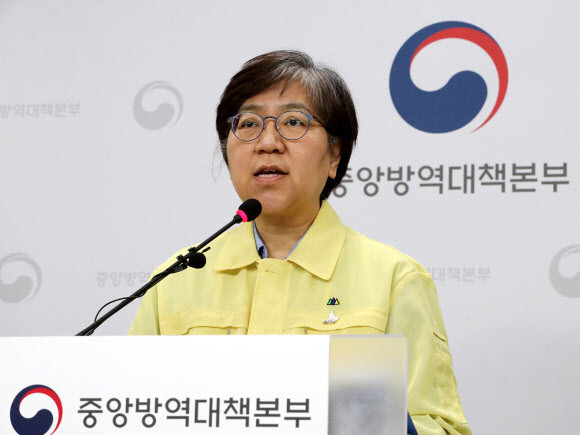hankyoreh
Links to other country sites 다른 나라 사이트 링크
KCDC to be given administrative autonomy from MOHW

The COVID-19 pandemic has prompted the South Korean government to implement organizational reforms that will help it respond more aggressively to the outbreak of infectious diseases. The Korea Centers for Disease Control and Prevention (KCDC) will be given administrative autonomy, and the Ministry of Health and Welfare (MOHW) will split its duties between two vice ministers, one in charge of welfare and the other in charge of public health.
The Ministry of the Interior and Safety (MOIS) announced the changes when it notified the public of a revision to the Government Organization Act on June 3.
As part of these changes, the KCDC, which has been subordinate to the MOHW, will be upgraded to an independent administrative agency at the vice-ministerial level. The upgrade will give the KCDC the independence to manage its own budget, personnel, and organization and effective authority to administer infectious disease policy.
South Korean President Moon Jae-in expressed his desire to upgrade the status of the KCDC during an address marking the third anniversary of his inauguration on May 10.
“We’ll be quickly expanding the KCDC’s organization and staff so that it can smoothly perform its enhanced functions, and we’ll continue to improve the KCDC’s human resource capabilities,” the MOIS said.
While the MOHW has previously only had a single vice minister, it will now have two, just like the Ministry of Economy and Finance, with the two vice ministers assuming separate roles. The first vice minister will be in charge of welfare, as well as planning and coordination, while the second vice minister will be in charge of public health.
Along with adopting a dual-vice ministerial system, the MOHW will also be strengthening its public health and medical capacities. The infectious disease research center at Korea’s National Institute of Health will be expanded and reorganized into a separate institute of its own. This new institute will develop programs for handling all stages of disease prevention, from monitoring for infectious disease to developing and commercializing medications and vaccines.
The central government has also decided to create a program for strengthening regional capabilities for preventing disease. The plan is to set up “disease response centers” in each region under the newly upgraded KCDC. The centers will be responsible for contact tracing on the ground in their respective regions.
After notifying the public of the revision to the Government Organization Act, the MOIS said it plans to quickly wrap up the government’s legislative preparations so that the revised bill can be discussed in the upcoming session of the National Assembly.
By Song Chae Kyung-hwa, staff reporter
Please direct comments or questions to [english@hani.co.kr]

Editorial・opinion
![[Guest essay] Amending the Constitution is Yoon’s key to leaving office in public’s good graces [Guest essay] Amending the Constitution is Yoon’s key to leaving office in public’s good graces](https://flexible.img.hani.co.kr/flexible/normal/500/300/imgdb/original/2024/0416/8917132552387962.jpg) [Guest essay] Amending the Constitution is Yoon’s key to leaving office in public’s good graces
[Guest essay] Amending the Constitution is Yoon’s key to leaving office in public’s good graces![[Editorial] 10 years on, lessons of Sewol tragedy must never be forgotten [Editorial] 10 years on, lessons of Sewol tragedy must never be forgotten](https://flexible.img.hani.co.kr/flexible/normal/500/300/imgdb/original/2024/0416/8317132536568958.jpg) [Editorial] 10 years on, lessons of Sewol tragedy must never be forgotten
[Editorial] 10 years on, lessons of Sewol tragedy must never be forgotten- [Column] A death blow to Korea’s prosecutor politics
- [Correspondent’s column] The US and the end of Japanese pacifism
- [Guest essay] How Korea turned its trainee doctors into monsters
- [Guest essay] As someone who helped forge Seoul-Moscow ties, their status today troubles me
- [Editorial] Koreans sent a loud and clear message to Yoon
- [Column] In Korea’s midterm elections, it’s time for accountability
- [Guest essay] At only 26, I’ve seen 4 wars in my home of Gaza
- [Column] Syngman Rhee’s bloody legacy in Jeju
Most viewed articles
- 1[Guest essay] Amending the Constitution is Yoon’s key to leaving office in public’s good graces
- 2Faith in the power of memory: Why these teens carry yellow ribbons for Sewol
- 3[Guest essay] How Korea turned its trainee doctors into monsters
- 4[Editorial] 10 years on, lessons of Sewol tragedy must never be forgotten
- 5K-pop a major contributor to boom in physical album sales worldwide, says IFPI analyst
- 6How Samsung’s promises of cutting-edge tech won US semiconductor grants on par with TSMC
- 7Korea ranks among 10 countries going backward on coal power, report shows
- 8Final search of Sewol hull complete, with 5 victims still missing
- 9[Column] A death blow to Korea’s prosecutor politics
- 10Exchange rate, oil prices, inflation: Can Korea overcome an economic triple whammy?